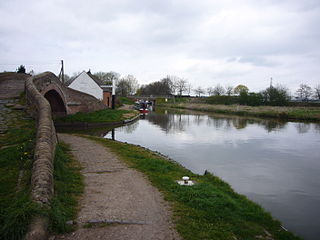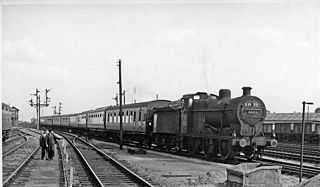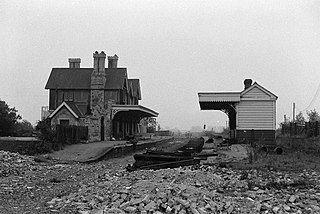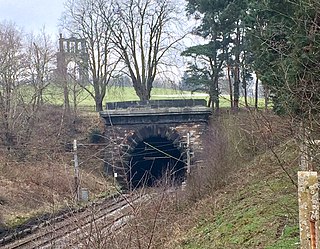
Sir George Gilbert Scott, largely known as Sir Gilbert Scott, was a prolific English Gothic Revival architect, chiefly associated with the design, building and renovation of churches and cathedrals, although he started his career as a leading designer of workhouses. Over 800 buildings were designed or altered by him.

Shugborough Hall is a stately home near Great Haywood, Staffordshire, England.
The year 1845 in architecture involved some significant architectural events and new buildings.

Great Haywood is a village in central Staffordshire, England, just off the A51 and about 4.5 miles (7.2 km) northwest of Rugeley and 7.1 miles (11.4 km) southeast of the county town of Stafford. Population details taken at the 2011 census can be found under Colwich.

Lichfield Trent Valley is one of two railway stations that serve the city of Lichfield in Staffordshire, England; the other being Lichfield City in the city centre. It is a split-level station: low level platforms serve the Trent Valley section of the West Coast Main Line, with a single high level platform being the northern terminus of the Cross-City Line.

Wansford is a village straddling the City of Peterborough and Huntingdonshire districts in the ceremonial county of Cambridgeshire, England. It had a population of 506 at the 2021 Census. It is situated 7 miles (11 km) west of Peterborough and 8 miles (13 km) miles south of Stamford. It is close to the county boundary with both Lincolnshire and Northamptonshire. The village is also located close to the A1 road and was on the route of the original Great North Road before the modern A1 was built. The village has since been bypassed by the A1 but the former Great North Road still exists through the village.

Atherstone is a railway station serving the market town of Atherstone in Warwickshire, England. It is on the Trent Valley section of the West Coast Main Line, exactly 102 miles (164 km) from London Euston station.

The Trent Valley line is a railway line between Rugby and Stafford in England, forming part of the West Coast Main Line. The line is 51 miles (82 km) long and is named after the River Trent which it follows. It was built to provide a direct route from London to North West England and Scotland, avoiding the slower route via Birmingham, which is congested and 7.75 miles (12.47 km) longer.

Peterborough East was a railway station in Peterborough, England. It was opened on 2 June 1845 and closed to passenger traffic on 6 June 1966. Located on East Station Road just off Town Bridge, only the engine sheds and one platform remain. The station had services running west to Northampton and Rugby, as well as to the east to March, Wisbech, and Norwich.

Wansford railway station is the headquarters of the Nene Valley Railway in Cambridgeshire, England. The station building was opened in 1995 and contains a ticket office, shop, cafe and toilets. The locomotive sheds are located at this station. Also at the station there is a picnic area and children's playground. The station was formerly the junction for a branch to Stamford, which separated to the north just east of the river bridge at Wansford.
Colwich is a civil parish and village in Staffordshire, England. It is situated off the A51 road, about 3 miles (5 km) north-west of Rugeley and 7 miles (11 km) south-east of Stafford. It lies principally on the north-east bank of the River Trent, near Wolseley Bridge and just north of The Chase. The parish comprises about 2,862 hectares (28.62 km2) of land in the villages and hamlets of Colwich, Great Haywood, Little Haywood, Moreton, Bishton and Wolseley Bridge.

Barnwell railway station is a former railway station in Barnwell, Northamptonshire on the former Northampton and Peterborough Railway line which connected Peterborough and Northampton.

See also Thrapston Midland Road

Northampton Bridge Street is a former railway station in Northampton, the main town of Northamptonshire, on the Northampton and Peterborough Railway which connected Peterborough and Northampton.
Shilton railway station was a railway station serving Shilton in the English county of Warwickshire, on the Trent Valley Line of the LNWR.
The Northampton and Peterborough Railway was an early railway promoted by the London and Birmingham Railway (L&BR) to run from a junction at Blisworth on the L&BR main line to Northampton and Peterborough, in England. The construction of the line was authorised by Parliament in 1843 and the 47 mile line opened in 1845. The line largely followed the river Nene, and for the economy of construction, it had many level crossings with intersecting roads, rather than bridges. In 1846 the L&BR joined with other companies, together forming the London and North Western Railway (LNWR).

Bulkington was a railway station on the Trent Valley Line serving the village of Bulkington, Warwickshire, England. The station was opened along with the line in 1847, and was closed in 1931.

Colwich railway station is a disused railway station in Colwich, Staffordshire, England. The former station is adjacent to Colwich Junction, where the Trent Valley Line to Stafford and the cut-off line to Stoke-on-Trent diverge.
Colwich is a civil parish in the Borough of Stafford, Staffordshire, England. It contains 73 listed buildings that are recorded in the National Heritage List for England. Of these, seven are listed at Grade I, the highest of the three grades, ten are at Grade II*, the middle grade, and the others are at Grade II, the lowest grade. The parish includes the villages of Colwich, Great Haywood, and Little Haywood, and the surrounding area. The most important building in the parish is Shugborough Hall, a large country house, which is listed together with associated structures and buildings in the grounds. The Trent and Mersey Canal passes through the parish, and joins the Staffordshire and Worcestershire Canal at Haywood Junction, and buildings associated with these canals include bridges, locks, mileposts, and a canal cottage and privy. The other listed buildings include churches, houses and associated structures, farmhouses, farm buildings, a public house, road and railway bridges, and a school.

The Shugborough Tunnel is a 777-yard (710 m) railway tunnel on the Trent Valley line running under part of the Shugborough Estate in Colwich, Staffordshire, England. It was constructed in 1846 by the Trent Valley Railway and is located between Stafford station and Colwich Junction. Both portals, which were designed by John Livock, are grade II listed.























